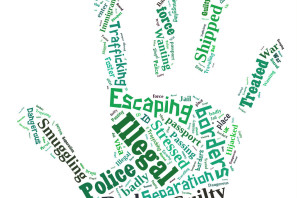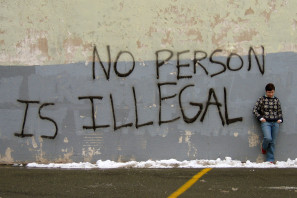Ours is a small secondary school for pupils age 7 to 13, with predominantly white, affluent children, including international boarding students from France, Spain, Japan, China, Russia and Nigeria. There is a strong international ethos, many bilingual staff and well-established links with France, incorporating elements of the French curriculum, an annual French exchange and regular school trips.
Religious Studies – opportunity for global learning
In Religious Studies, the Year 8 (age 12 to 13) class took part in a short unit of work on immigration. Given the 2014 European and local elections, and the media focus on the success of UKIP (the United Kingdom Independence Party), this topic provided an opportunity for open discussion and the dispelling of myths. It was important to assess the baseline level of understanding and pre-existing attitudes of participating pupils in order to plan work appropriately. Repeating the audit activities later was unfortunately impossible owing to last minute end-of-term arrangements.
The key aims of the short topic were:
- To broaden the knowledge and understanding of key terms linked to immigration, and develop pupils’ ability to evaluate sources of information critically.
- To provide the opportunity to discuss openly and evaluate different viewpoints and possibly to adjust own attitudes in the light of new information.
Audit activity 1: Putting yourself in someone else’s shoes
Working individually to avoid potential copying of others’ views, pupils were asked to finish a series of sentences by suggesting appropriate words to describe the most likely feelings experienced. They were also asked to explain the reasons for the feeling given. This activity was designed to establish how well pupils could identify with people in given situations, before introducing the topic of immigration. Thus the word immigrant was deliberately avoided. Here are the sentences they were asked to finish:
If someone had to move house they might feel… …because …..
If someone had just arrived in a new country they might feel… because …..
If someone did not speak the main language in their new country they might feel… because …..
If someone had to live in a different country from the rest of their family they might feel… because….
If someone tried to enter a country illegally they might feel… because …..
Overall there were some very sensitive and mature responses, showing a high degree of empathy and compassion towards people in the situations described. I had considered providing a word bank for this activity, but the decision not to do so was proved correct, as the pupils proposed numerous terms I had not previously considered; a word bank could however still be useful for less able or younger pupils. The pupils gave well-thought-through reasons for their responses, often showing a good level of understanding of the challenges a person moving country might experience.
Overall, a high level of sensitivity was revealed. However, when this was followed up with a task exploring an article about the impact of immigration in Britain, the class gave a different general response, revealing much higher negativity towards immigrants.
With more time, it would have been interesting to explore this dissonance more fully, perhaps through presenting the class with a summary of their findings from the initial activity (e.g. in a Wordle) and explicitly making the comparison with some real groups of people who find themselves in the situations described. It seemed that it was easier to empathise in the abstract with imaginary immigrants, without a given nationality, than with real people with a background story. This was interesting as I had expected that a real story would be more likely to arouse feelings of understanding and compassion.
It would be good to build on the responses about the perceived problems of newly-arrived immigrants who do not have their family around or speak the language, and perhaps discuss what UK citizens could do to make people feel more welcome, ease their settling in and overcome the language barrier.
The final question on illegal immigration lends itself to further work on the reasons why people might be driven to enter a country in this way, and the deeper motivations, such as poverty, inequality and oppression.
Audit activity 2: Immigrants, Asylum seekers and Refugees – What do you already know and feel?
Pupils were given a blank sheet with four outlines of figures. They were asked to label the first figure Immigrant and to write inside it anything they associate with that label (e.g. places, feelings, or definitions). If they did not know the meaning of the label they could put a ‘?’ This activity was repeated with the second figure, labelled Asylum seeker, the third, labelled Refugee and finally the fourth, labelled Illegal Immigrant. It was important to give out the labels one at a time so as not influence pupils’ ideas by revealing the theme of the labels and having them make links between the words.
This activity was designed to encourage pupils to reveal their pre-existing knowledge, along with any misconceptions or misunderstandings. The type of words used would reveal their underlying feelings and attitudes towards the named groups of people.
By repeating the activity at the end of the unit of work, it would be possible to make comparisons between the terms used, the level of accuracy in definitions given and the level of empathy and compassion shown. This would also highlight any awareness of multiple viewpoints.
Graphics using Tagxedo were created to show the most common responses to the following words: asylum seeker, illegal immigrant, immigrant and refugee.
Overview of findings
The results revealed that the word immigrant (when viewed alone) was seen as synonymous with illegal immigrant by many, and the term asylum seeker was unfamiliar to most pupils. Refugee was a better understood term. The exercise was interesting and useful for encouraging pupils to reveal their starting point in a non-threatening exercise. They were not inhibited at putting forward ideas that might have been incorrect, as they were told it did not matter if the words were right or wrong and that they were not being judged on any responses they gave. I would definitely repeat this activity, and could use it again with other topics to reveal preconceptions/misconceptions that might need to be addressed.
What could be done to follow up?
There was a clear need for work to address precise definitions of the terms refugee, asylum seeker, immigrant and illegal immigrant. Equally, a range of negative attitudes had been expressed which presented an opportunity for work to develop critical thinking and the ability to look at the issue of immigration from multiple viewpoints. Pupils would thus have the chance to justify and/or modify their viewpoints.






